ESP CHEVROLET DURAMAX 2006 Owners Manual
[x] Cancel search | Manufacturer: CHEVROLET, Model Year: 2006, Model line: DURAMAX, Model: CHEVROLET DURAMAX 2006Pages: 100, PDF Size: 0.71 MB
Page 2 of 100
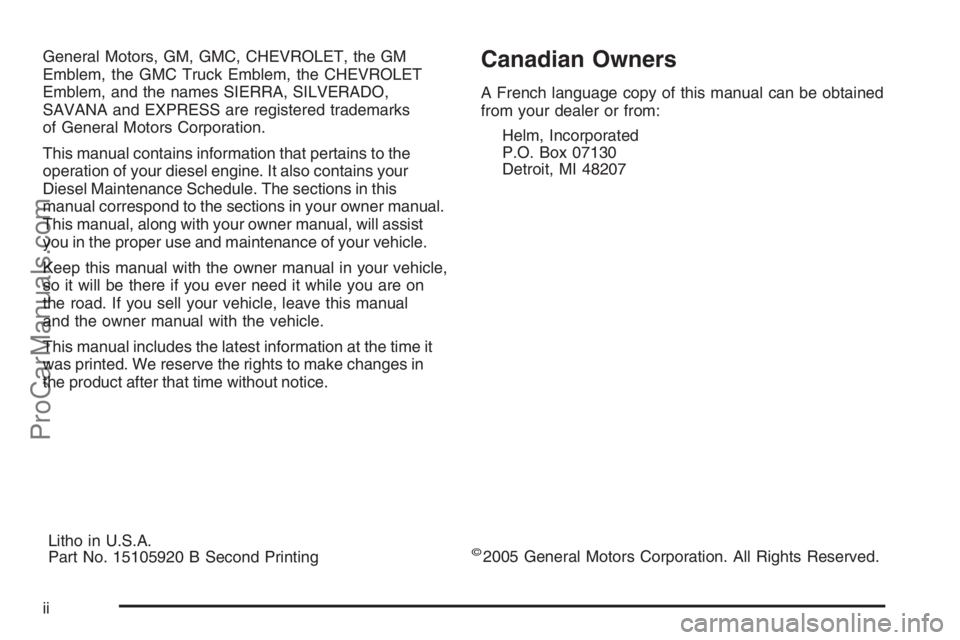
General Motors, GM, GMC, CHEVROLET, the GM
Emblem, the GMC Truck Emblem, the CHEVROLET
Emblem, and the names SIERRA, SILVERADO,
SAVANA and EXPRESS are registered trademarks
of General Motors Corporation.
This manual contains information that pertains to the
operation of your diesel engine. It also contains your
Diesel Maintenance Schedule. The sections in this
manual correspond to the sections in your owner manual.
This manual, along with your owner manual, will assist
you in the proper use and maintenance of your vehicle.
Keep this manual with the owner manual in your vehicle,
so it will be there if you ever need it while you are on
the road. If you sell your vehicle, leave this manual
and the owner manual with the vehicle.
This manual includes the latest information at the time it
was printed. We reserve the rights to make changes in
the product after that time without notice.Canadian Owners
A French language copy of this manual can be obtained
from your dealer or from:
Helm, Incorporated
P.O. Box 07130
Detroit, MI 48207
Litho in U.S.A.
Part No. 15105920 B Second Printing
©2005 General Motors Corporation. All Rights Reserved.
ii
ProCarManuals.com
Page 18 of 100
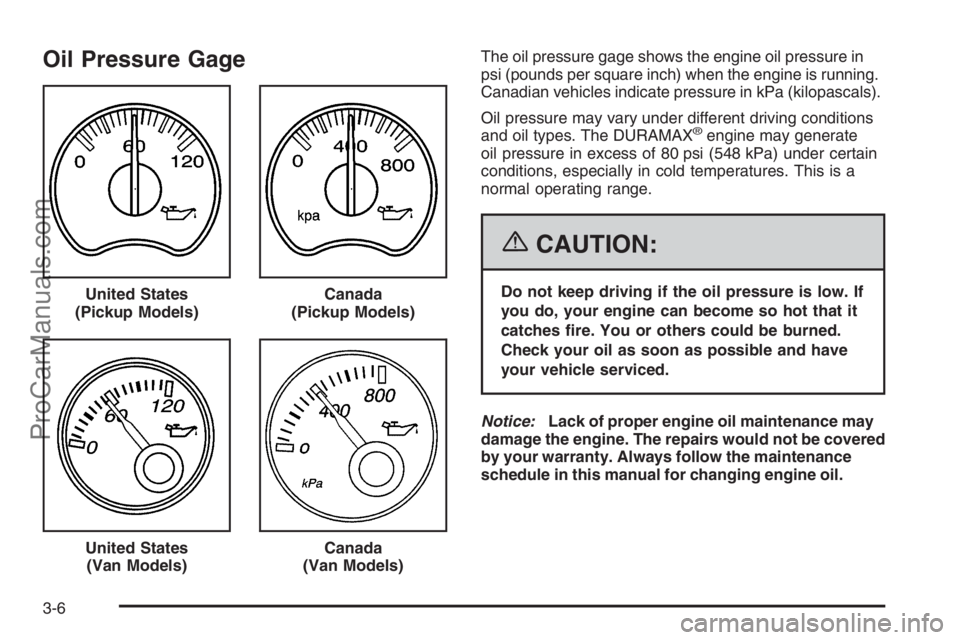
Oil Pressure GageThe oil pressure gage shows the engine oil pressure in
psi (pounds per square inch) when the engine is running.
Canadian vehicles indicate pressure in kPa (kilopascals).
Oil pressure may vary under different driving conditions
and oil types. The DURAMAX
®engine may generate
oil pressure in excess of 80 psi (548 kPa) under certain
conditions, especially in cold temperatures. This is a
normal operating range.
{CAUTION:
Do not keep driving if the oil pressure is low. If
you do, your engine can become so hot that it
catches �re. You or others could be burned.
Check your oil as soon as possible and have
your vehicle serviced.
Notice:Lack of proper engine oil maintenance may
damage the engine. The repairs would not be covered
by your warranty. Always follow the maintenance
schedule in this manual for changing engine oil. United States
(Pickup Models)Canada
(Pickup Models)
United States
(Van Models)Canada
(Van Models)
3-6
ProCarManuals.com
Page 27 of 100
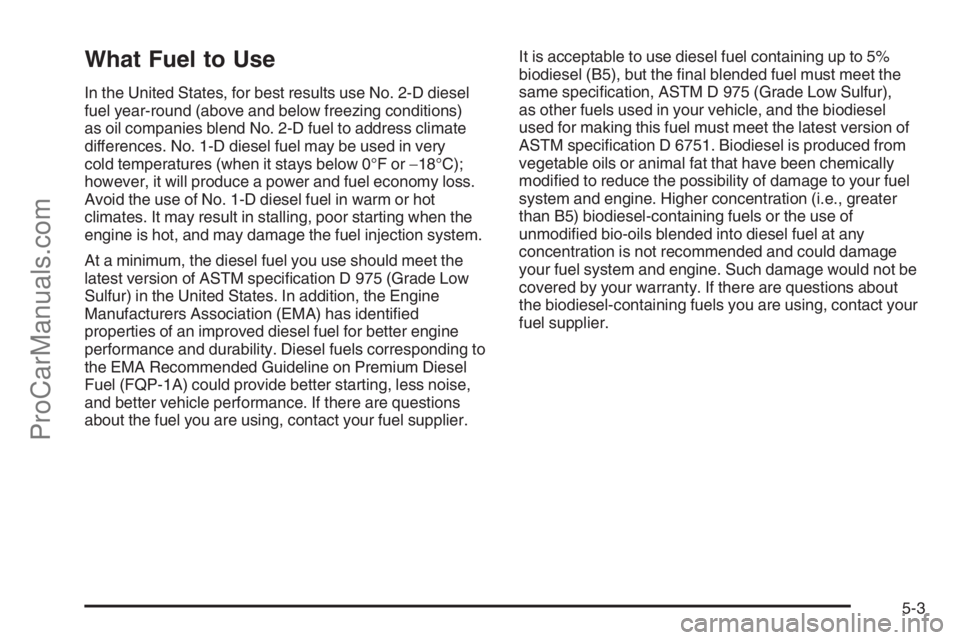
What Fuel to Use
In the United States, for best results use No. 2-D diesel
fuel year-round (above and below freezing conditions)
as oil companies blend No. 2-D fuel to address climate
differences. No. 1-D diesel fuel may be used in very
cold temperatures (when it stays below 0°F or−18°C);
however, it will produce a power and fuel economy loss.
Avoid the use of No. 1-D diesel fuel in warm or hot
climates. It may result in stalling, poor starting when the
engine is hot, and may damage the fuel injection system.
At a minimum, the diesel fuel you use should meet the
latest version of ASTM specification D 975 (Grade Low
Sulfur) in the United States. In addition, the Engine
Manufacturers Association (EMA) has identified
properties of an improved diesel fuel for better engine
performance and durability. Diesel fuels corresponding to
the EMA Recommended Guideline on Premium Diesel
Fuel (FQP-1A) could provide better starting, less noise,
and better vehicle performance. If there are questions
about the fuel you are using, contact your fuel supplier.It is acceptable to use diesel fuel containing up to 5%
biodiesel (B5), but the final blended fuel must meet the
same specification, ASTM D 975 (Grade Low Sulfur),
as other fuels used in your vehicle, and the biodiesel
used for making this fuel must meet the latest version of
ASTM specification D 6751. Biodiesel is produced from
vegetable oils or animal fat that have been chemically
modified to reduce the possibility of damage to your fuel
system and engine. Higher concentration (i.e., greater
than B5) biodiesel-containing fuels or the use of
unmodified bio-oils blended into diesel fuel at any
concentration is not recommended and could damage
your fuel system and engine. Such damage would not be
covered by your warranty. If there are questions about
the biodiesel-containing fuels you are using, contact your
fuel supplier.
5-3
ProCarManuals.com
Page 28 of 100
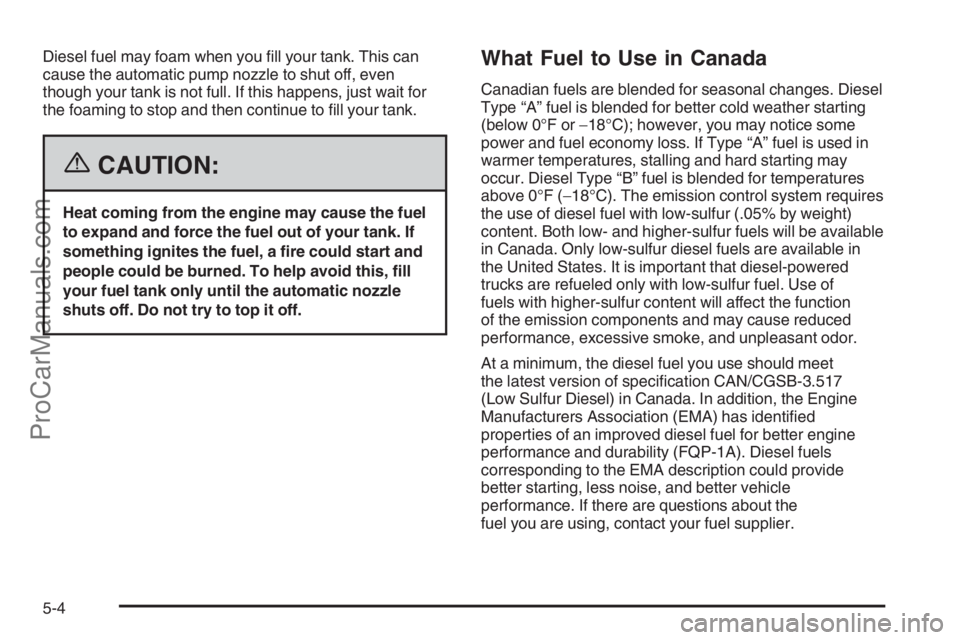
Diesel fuel may foam when you fill your tank. This can
cause the automatic pump nozzle to shut off, even
though your tank is not full. If this happens, just wait for
the foaming to stop and then continue to fill your tank.
{CAUTION:
Heat coming from the engine may cause the fuel
to expand and force the fuel out of your tank. If
something ignites the fuel, a �re could start and
people could be burned. To help avoid this, �ll
your fuel tank only until the automatic nozzle
shuts off. Do not try to top it off.
What Fuel to Use in Canada
Canadian fuels are blended for seasonal changes. Diesel
Type “A” fuel is blended for better cold weather starting
(below 0°F or−18°C); however, you may notice some
power and fuel economy loss. If Type “A” fuel is used in
warmer temperatures, stalling and hard starting may
occur. Diesel Type “B” fuel is blended for temperatures
above 0°F (−18°C). The emission control system requires
the use of diesel fuel with low-sulfur (.05% by weight)
content. Both low- and higher-sulfur fuels will be available
in Canada. Only low-sulfur diesel fuels are available in
the United States. It is important that diesel-powered
trucks are refueled only with low-sulfur fuel. Use of
fuels with higher-sulfur content will affect the function
of the emission components and may cause reduced
performance, excessive smoke, and unpleasant odor.
At a minimum, the diesel fuel you use should meet
the latest version of specification CAN/CGSB-3.517
(Low Sulfur Diesel) in Canada. In addition, the Engine
Manufacturers Association (EMA) has identified
properties of an improved diesel fuel for better engine
performance and durability (FQP-1A). Diesel fuels
corresponding to the EMA description could provide
better starting, less noise, and better vehicle
performance. If there are questions about the
fuel you are using, contact your fuel supplier.
5-4
ProCarManuals.com
Page 45 of 100
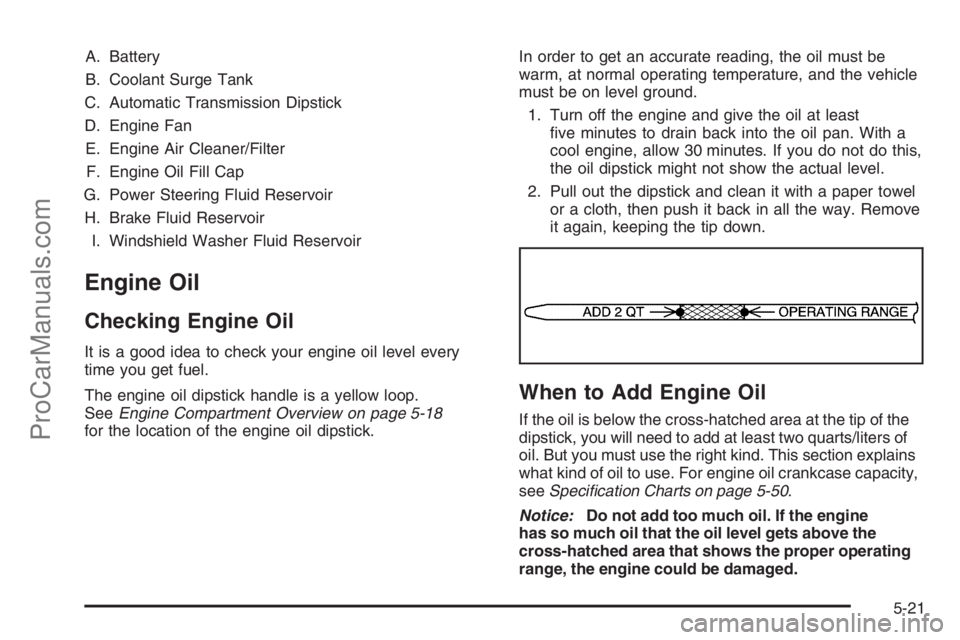
A. Battery
B. Coolant Surge Tank
C. Automatic Transmission Dipstick
D. Engine Fan
E. Engine Air Cleaner/Filter
F. Engine Oil Fill Cap
G. Power Steering Fluid Reservoir
H. Brake Fluid Reservoir
I. Windshield Washer Fluid Reservoir
Engine Oil
Checking Engine Oil
It is a good idea to check your engine oil level every
time you get fuel.
The engine oil dipstick handle is a yellow loop.
SeeEngine Compartment Overview on page 5-18
for the location of the engine oil dipstick.In order to get an accurate reading, the oil must be
warm, at normal operating temperature, and the vehicle
must be on level ground.
1. Turn off the engine and give the oil at least
five minutes to drain back into the oil pan. With a
cool engine, allow 30 minutes. If you do not do this,
the oil dipstick might not show the actual level.
2. Pull out the dipstick and clean it with a paper towel
or a cloth, then push it back in all the way. Remove
it again, keeping the tip down.
When to Add Engine Oil
If the oil is below the cross-hatched area at the tip of the
dipstick, you will need to add at least two quarts/liters of
oil. But you must use the right kind. This section explains
what kind of oil to use. For engine oil crankcase capacity,
seeSpeci�cation Charts on page 5-50.
Notice:Do not add too much oil. If the engine
has so much oil that the oil level gets above the
cross-hatched area that shows the proper operating
range, the engine could be damaged.
5-21
ProCarManuals.com
Page 53 of 100
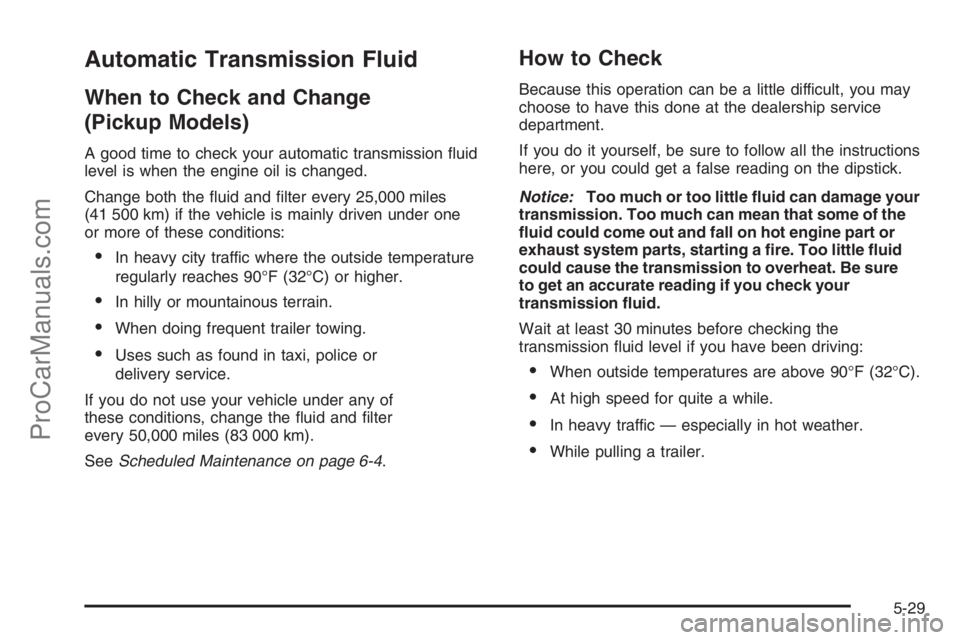
Automatic Transmission Fluid
When to Check and Change
(Pickup Models)
A good time to check your automatic transmission fluid
level is when the engine oil is changed.
Change both the fluid and filter every 25,000 miles
(41 500 km) if the vehicle is mainly driven under one
or more of these conditions:
•In heavy city traffic where the outside temperature
regularly reaches 90°F (32°C) or higher.
•In hilly or mountainous terrain.
•When doing frequent trailer towing.
•Uses such as found in taxi, police or
delivery service.
If you do not use your vehicle under any of
these conditions, change the fluid and filter
every 50,000 miles (83 000 km).
SeeScheduled Maintenance on page 6-4.
How to Check
Because this operation can be a little difficult, you may
choose to have this done at the dealership service
department.
If you do it yourself, be sure to follow all the instructions
here, or you could get a false reading on the dipstick.
Notice:Too much or too little �uid can damage your
transmission. Too much can mean that some of the
�uid could come out and fall on hot engine part or
exhaust system parts, starting a �re. Too little �uid
could cause the transmission to overheat. Be sure
to get an accurate reading if you check your
transmission �uid.
Wait at least 30 minutes before checking the
transmission fluid level if you have been driving:
•When outside temperatures are above 90°F (32°C).
•At high speed for quite a while.
•In heavy traffic — especially in hot weather.
•While pulling a trailer.
5-29
ProCarManuals.com
Page 56 of 100
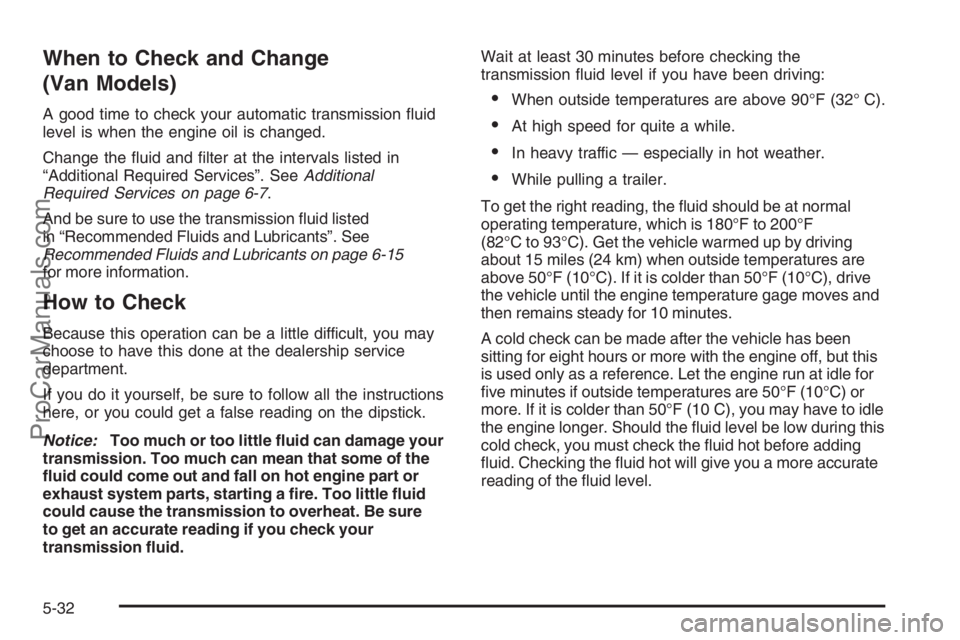
When to Check and Change
(Van Models)
A good time to check your automatic transmission fluid
level is when the engine oil is changed.
Change the fluid and filter at the intervals listed in
“Additional Required Services”. SeeAdditional
Required Services on page 6-7.
And be sure to use the transmission fluid listed
in “Recommended Fluids and Lubricants”. See
Recommended Fluids and Lubricants on page 6-15
for more information.
How to Check
Because this operation can be a little difficult, you may
choose to have this done at the dealership service
department.
If you do it yourself, be sure to follow all the instructions
here, or you could get a false reading on the dipstick.
Notice:Too much or too little �uid can damage your
transmission. Too much can mean that some of the
�uid could come out and fall on hot engine part or
exhaust system parts, starting a �re. Too little �uid
could cause the transmission to overheat. Be sure
to get an accurate reading if you check your
transmission �uid.Wait at least 30 minutes before checking the
transmission fluid level if you have been driving:
•When outside temperatures are above 90°F (32° C).
•At high speed for quite a while.
•In heavy traffic — especially in hot weather.
•While pulling a trailer.
To get the right reading, the fluid should be at normal
operating temperature, which is 180°F to 200°F
(82°C to 93°C). Get the vehicle warmed up by driving
about 15 miles (24 km) when outside temperatures are
above 50°F (10°C). If it is colder than 50°F (10°C), drive
the vehicle until the engine temperature gage moves and
then remains steady for 10 minutes.
A cold check can be made after the vehicle has been
sitting for eight hours or more with the engine off, but this
is used only as a reference. Let the engine run at idle for
five minutes if outside temperatures are 50°F (10°C) or
more. If it is colder than 50°F (10 C), you may have to idle
the engine longer. Should the fluid level be low during this
cold check, you must check the fluid hot before adding
fluid. Checking the fluid hot will give you a more accurate
reading of the fluid level.
5-32
ProCarManuals.com
Page 91 of 100
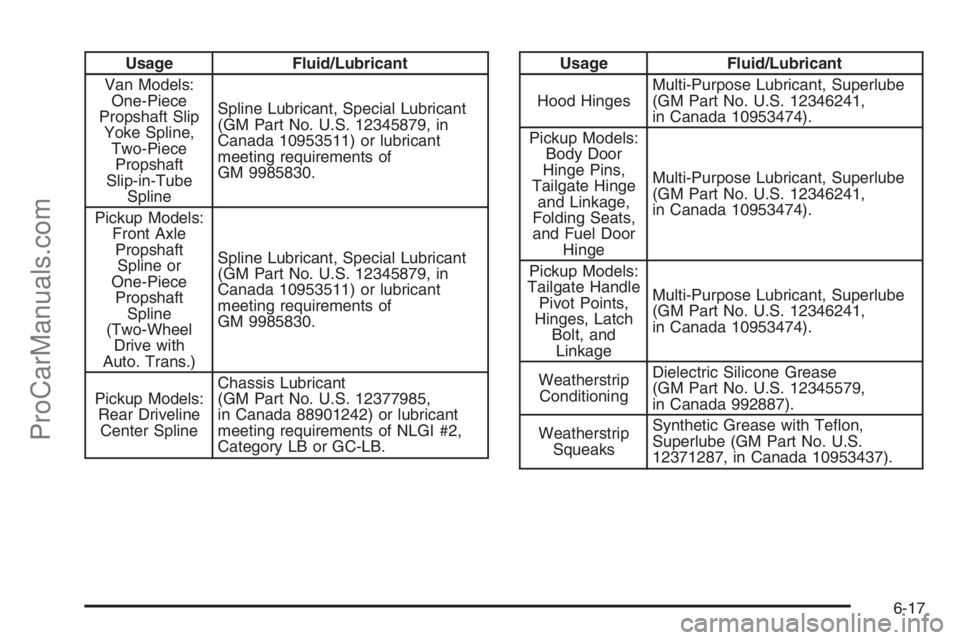
Usage Fluid/Lubricant
Van Models:
One-Piece
Propshaft Slip
Yoke Spline,
Two-Piece
Propshaft
Slip-in-Tube
SplineSpline Lubricant, Special Lubricant
(GM Part No. U.S. 12345879, in
Canada 10953511) or lubricant
meeting requirements of
GM 9985830.
Pickup Models:
Front Axle
Propshaft
Spline or
One-Piece
Propshaft
Spline
(Two-Wheel
Drive with
Auto. Trans.)Spline Lubricant, Special Lubricant
(GM Part No. U.S. 12345879, in
Canada 10953511) or lubricant
meeting requirements of
GM 9985830.
Pickup Models:
Rear Driveline
Center SplineChassis Lubricant
(GM Part No. U.S. 12377985,
in Canada 88901242) or lubricant
meeting requirements of NLGI #2,
Category LB or GC-LB.Usage Fluid/Lubricant
Hood HingesMulti-Purpose Lubricant, Superlube
(GM Part No. U.S. 12346241,
in Canada 10953474).
Pickup Models:
Body Door
Hinge Pins,
Tailgate Hinge
and Linkage,
Folding Seats,
and Fuel Door
HingeMulti-Purpose Lubricant, Superlube
(GM Part No. U.S. 12346241,
in Canada 10953474).
Pickup Models:
Tailgate Handle
Pivot Points,
Hinges, Latch
Bolt, and
LinkageMulti-Purpose Lubricant, Superlube
(GM Part No. U.S. 12346241,
in Canada 10953474).
Weatherstrip
ConditioningDielectric Silicone Grease
(GM Part No. U.S. 12345579,
in Canada 992887).
Weatherstrip
SqueaksSynthetic Grease with Teflon,
Superlube (GM Part No. U.S.
12371287, in Canada 10953437).
6-17
ProCarManuals.com